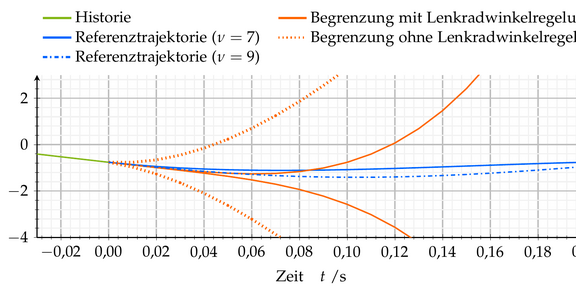Examination of the reference trajectory for compliance with the current driving dynamics state

The reference trajectory for automated driving functions is usually determined using planning algorithms based on simplifying assumptions about vehicle dynamics. Commonly, a mass point model is utilized as the underlying basis for planning. However, in order to accurately control the trajectory, it must be ensured that the trajectory can also be realized for the vehicle. For this purpose, the initial condition of the reference trajectory must correspond to the current motion behavior of the ego vehicle. Therefore, not only the vehicle dynamics must be considered, but also the underlying actuators, such as the steering wheel angle motor.
For an exemplary planning approach which generates a reference trajectory by means of a sampling point generation and a subsequent spline interpolation, the compliance with the current driving state is investigated. For this, the spline order is increased step by step so that more constraints can be imposed on the shape of the trajectory. It can be shown that a quintic spline, respectively for the lateral and longitudinal motion, leads to a discontinuity of the course rate between the current motion and the planned motion. A septic spline only considers the constraints of the driving dynamics. To account for the dynamics of the underlying steering wheel angle control, the spline order must be further increased.

![[Translate to English:] [Translate to English:]](/storages/zentraler_bilderpool/_processed_/8/b/csm_Kopfbild_Orga_Luftbild_9523d53350.jpg)